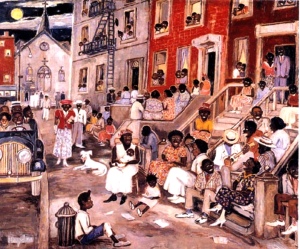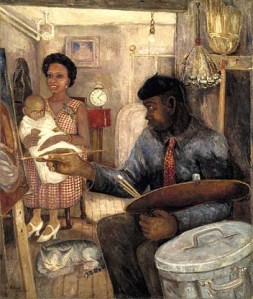Palmer Hayden
Palmer Hayden was an artist in Harlem who faced many different forms of racism and criticism. As a young, high school aged aspiring artist, Palmer Hayden wanted to be an artist’s assistant. He showed up to an interview but was turned away after the interviewer realized he was black. Although Palmer Hayden had dealt with racism on a personal level many artist accused his paintings of adding to the stereotypes. His paintings usually portrayed black Americans as lower class and sometimes mischievous. He was also often ridiculed for the way his paintings resembled the black face minstrel character. This character was historically used to make fun of black Americans so many blacks felt his paintings fed the white people’s racist hunger. Although Palmer Hayden faced many critics he also had many black artist advocating for his work. Palmer Hayden was one of the most influential artists during the Harlem Renaissance.
The Janitor Who Paints
1937
Oil on canvas
The Janitor Who Paints was one of Palmer Hayden’s controversial paintings. Hayden was ridiculed by black artists because of they way the man (who was meant to represent Palmer Hayden) in the painting was portrayed. Some people thought that Palmer Hayden was adding to the “black stereotype” because of the way he illustrated the janitor’s features. The janitor had large hands and large lips; those features were commonly associated with the racist minstrel characters. People also thought that Hayden added to the stereotype because he depicted the subject in the painting to be a working class janitor. Although some black artists applauded and supported Hayden’s painting, many other black artists spoke out against his painting and thought that the painting was feeding the hunger of racist white Americans. Palmer Hayden decided, due to the overwhelming amount of anger and criticism from his fellow black American artists, that he would alter “The Janitor Who Paints”.
Nous Quatre a Paris
1930
Watercolor and grafite on paper
Nous Quatre A Paris is another one of Palmer Hayden’s work’s that was ridiculed for containing minstrel-like features. The big lips and hands of the people tend to be a pattern of Palmer Hayden’s paintings. This piece of artwork was made in 1930, which is the same time period during which the probation was implemented. The four men are playing a game of poker, except none of them are looking at their cards. One could infer that because of the illegal presence of the wine, the men are on edge and frightened of getting caught by an authority figure. Palmer Hayden was ridiculed and criticized by other black Americans for this painting because of the exaggerated features of the characters, but more intensely for the implied criminal activity. They did not appreciate when Palmer Hayden, consciously or not, added or affirmed the stereotypes that they were trying to get rid of.

Midsummer Night in Harlem
1938
Oil on canvas
Midsummer Night in Harlem was meant to embody the community in Harlem. Palmer Hayden portrayed a high-energy community sitting outside of their houses to cool off on a hot summer night. This painting shows the energy and positive attitude through vibrant colors and the expressions of the people. They all have smiles and nice “Sunday church” outfits on. It is fair to assume that the people had just come from church because Palmer Hayden has people still lingering out of the church in the background. Midsummer Night in Harlem was another one of Palmer Hayden’s paintings that got a negative reaction from some black Americans because of how interpreted their physical features. The people in this photo once again had features that were comparable to the minstrel characters. They all have very dark skin, big white eyes, and big mouths. James Porter criticized Palmer Hayden’s painting of “Midsummer Night In Harlem” because of the minstrel characters; he called the artwork “talent gone astray”.

